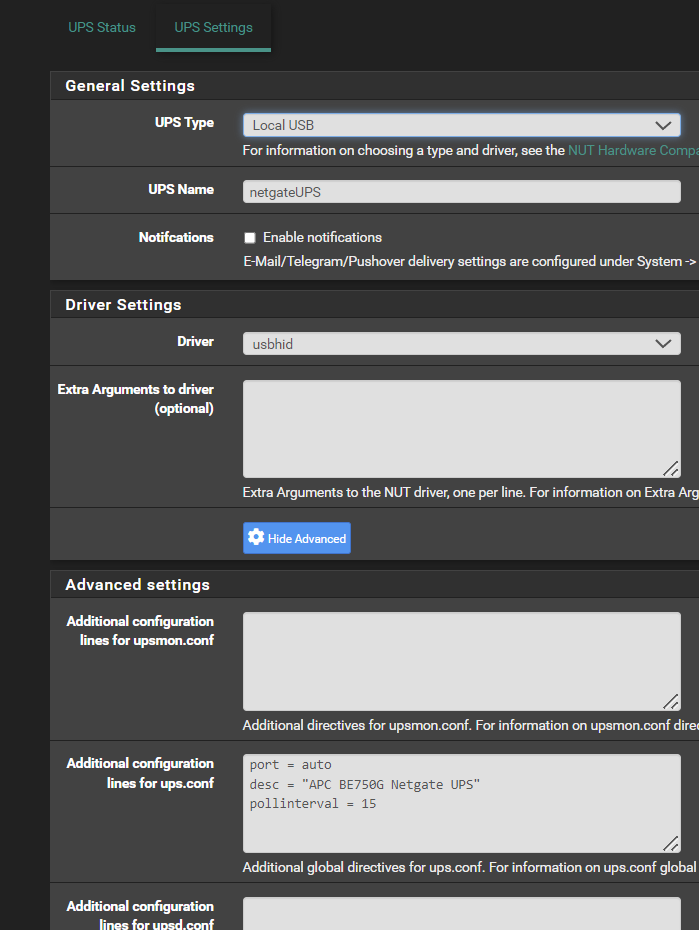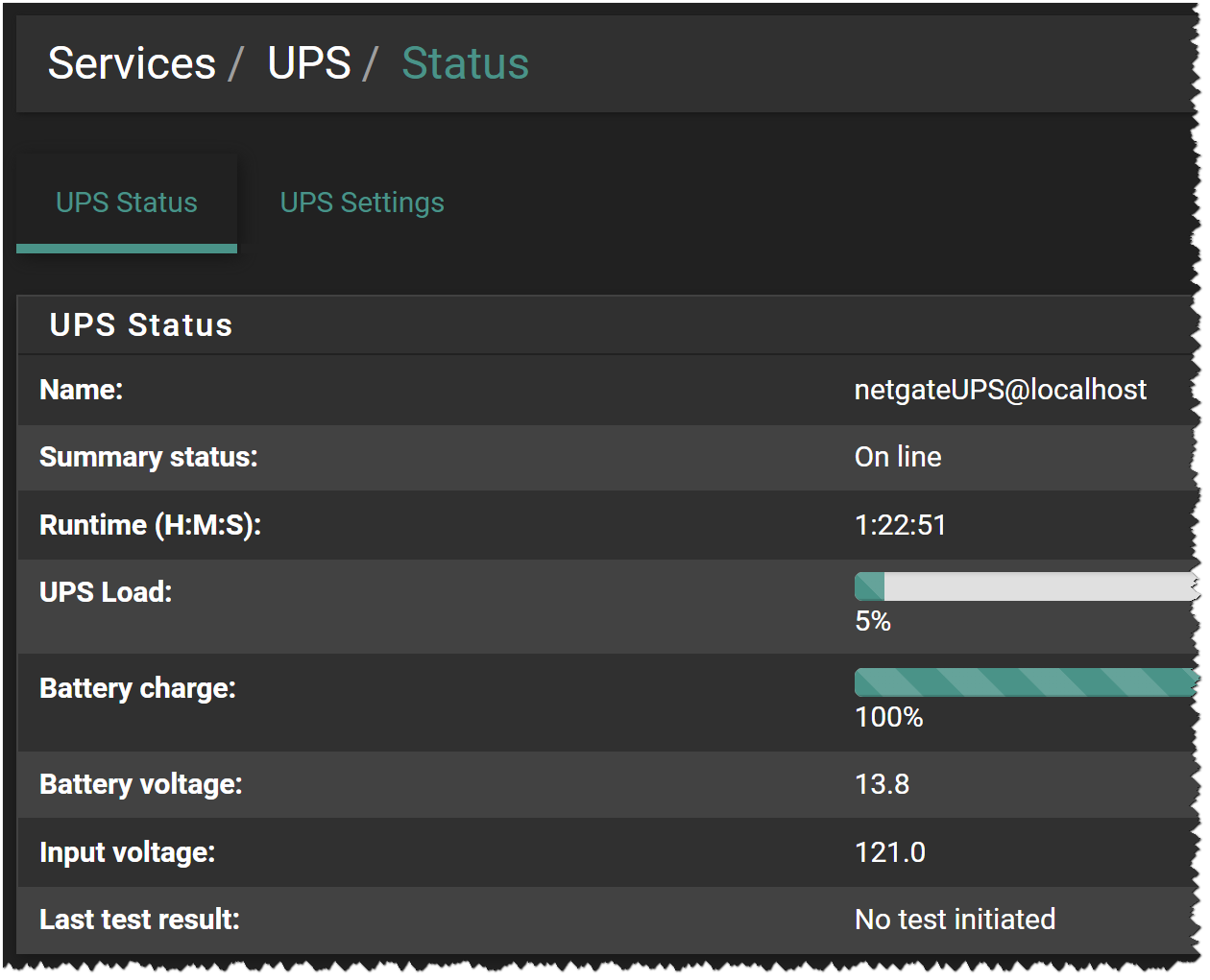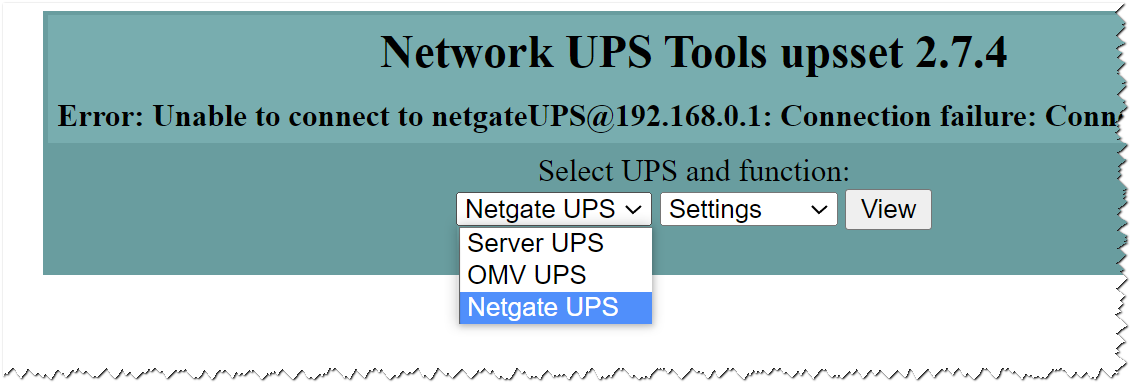NUT server and UPS general question
-
@stephenw10
Just to be clear this is my setup:-
Connect one adapter to the USB of UPS and connect the ethernet to the existing ethernet wall jack near the UPS
-
In the switch at my server rack connect from switch to my adapter using patch cable and then connect the USB to my raspberry PI.
Can I give it a try? What is your opinion? I am not asking you to vouch for it? If it fails that is ok
-
-
No that won't work. It can't go through the switch.
You have to connect directly to incoming cable that's connected to that wall jack.
-
I forget which model APC UPS you have (did you say?). If it is a Smart-UPS with a slot, and remote monitoring is important to you, then you'd be better off getting an APC network management card, they can be found secondhand for not too much.
-
@stephenw10 Oh Ok Got it ! Does it matter if this is a dump switch or managed switch?
-
@occamsrazor said in NUT server and UPS general question:
I forget which model APC UPS you have (did you say?). If it is a Smart-UPS with a slot, and remote monitoring is important to you, then you'd be better off getting an APC network management card, they can be found secondhand for not too much.
I am looking for cheapo consumer variety.....thx anyway
-
@netboy No, neither will pass USB signals.
-
@stephenw10
Got it!
Alternative is to use my UPS near NAS as standalone. The NAS has configuration for the NAS to run for xx minutes before shutting down (NAS can communicate to the UPS).
Thanks all. -
So, one question comes to mind: Is your intent to manage the UPSs and attached devices, or just display their status?
If the UPSs have computer systems attached to them, you want each system to manage the UPS that controls its power. This is important to allow the computer system to execute its shutdown at the appropriate time. Your NAS is a good example of this. On the other hand, if all the devices attached to the UPS lack the ability to shutdown, say like a cable modem or printer, then no active UPS management is needed (or appropriate).
Either way you can use NUT on your Pi to display the status of the multiple UPSs. Remote NUT connection for systems that run NUT and manage their own UPS (such as your NAS), and (perhaps) direct USB or other approaches for systems that do not have attached computer systems.
Regardless, you're going to need to read up a bit on NUT. You need to configure NUT to simply report status rather than take action for the UPSs that do not control the power to the Pi.
-
@dennypage Excellent point.
First iteration (I am learning).... I need a visibility of all the UPS's. Right now I don't. I want to know how healthy the UPS's are and so on.....On second iteration (After I have learned a little).... I would like NUT to control shut down UPS 3
UPS 1
-
Modem
-
Router
-
POE switches
UPS 2
-
Dump Switches
-
HDHomerun
-
Raspberry PI which has NUT installed
UPS 3
- 3 servers
UPS 4
- Attached to NAS which can communicate to UPS
I want UPS 3 to control shut down my servers. Is this possible using NUT (I know you are the package owner and are very knowledgeable). My servers are debian UBUNTU. UPS 1: I really do not care about control shut down because there is nothing to fail (like hard disk getting corrupted and so on ) and also they have the max run time. Regarding UPS 3 I really do not care because they are just switches. Worst case things attached to the switches will not work.
What do you think? Can I make UBUNTU servers talk to NUT and control shut down?
-
-
@netboy Yes, you can do all this with NUT. This would be more appropriate to the the NUT users list, but the general gist is this...
UPS 1: Attach the UPS to some system and run NUT as monitor only (use 0 as the power value for upsmon).
UPS 2: Run standard NUT Primary on the Pi.
UPS 3: Pick a system to be the Primary and run a standard NUT Primary install on that system. Run NUT Secondary on the other systems using remote NUT to the Primary.
UPS 4: Run NUT on the NAS. If Synology or QNAP, this is the standard supported UPS install.
In addition to the above, run upsmon on the Pi to monitor all the UPSs and display status with cgi scripts. Look for upsstats.
Lots of reading for you to do...

-
@dennypage @dennypage said in NUT server and UPS general question:
UPS 3: Pick a system to be the Primary and run a standard NUT Primary install on that system. Run NUT Secondary on the other systems using remote NUT to the Primary.
Let me parse your reply

In my case 3 servers....Pick one server as PRIMARY say server 1 and install standard NUT on server 1. Install NUT secondary on server 2 and server 3. Run Remote NUT to the primary. I am going NUTS. In other words this UPS 3 is stand alone "farm" no connection to NUT installed in raspberry PI.UPS 1: Attach the UPS to some system and run NUT as monitor only (use 0 as the power value for upsmon).
UPS 2: Run standard NUT Primary on the Pi.For above 2 scenario's Rasberry PI is to be used. The configuration for NUT in PI for UPS 1 is monitor only and UPS 2 is standard NUT as primary
Have I understood it marginally?
-
@netboy dennypage, I did some reading......
The UPS 3 has 3 servers and one of them is Openmediavault (OMV) and 2 of them or ubuntu.It so happens, OMV has a NUT package and I installed it after making sure my UPS is connected to OMV using USB (checked lsusb to make sure the UPS shows up). The package worked as standalone.
The package has another option called REMOTE MONITORING (Enable remote monitoring of the local connected UPS.) which I believe is a server mode (or PRIMARY in your speak as I understand).
So here is what I think are my next steps:-
Enable server mode in OMV (with some username/pswd)
-
Install NUT client in server 2 and 3 (ubuntu) and point them to OMV using username/pswd (SECONDARY in your speak)
And finagle it to work.
Have I got it right so far?
-
-
@netboy said in NUT server and UPS general question:
In my case 3 servers....Pick one server as PRIMARY say server 1 and install standard NUT on server 1. Install NUT secondary on server 2 and server 3. Run Remote NUT to the primary. I am going NUTS. In other words this UPS 3 is stand alone "farm" no connection to NUT installed in raspberry PI.
Server 1 would be the NUT Primary (NUT's new term--previously called master), and would perform the actual control of the UPS. Server 2 & 3 would be Secondaries (previously called slaves), and take their instruction from the Primary. When the Primary says "time to shut down" the Secondaries shut down and disconnect from the Primary, after which the Primary shuts down which kills UPS power.
Note that you can still "monitor" the the Server 1 UPS using NUT on another host (Pi). You would configure it as a Secondary, but use a power value of 0 to indicated that you are not actually connected to the UPS on Server 1. You can use this approach to monitor all the other UPSs from the Pi as well.
-
@netboy said in NUT server and UPS general question:
It so happens, OMV has a NUT package and I installed it after making sure my UPS is connected to OMV using USB (checked lsusb to make sure the UPS shows up).
Just about everyone has a NUT package. It's pretty universal.
Have I got it right so far?
I believe so.
-
@dennypage Thank you.... shall read more and figure it out
-
This post is deleted! -
@dennypage said in NUT server and UPS general question:
Server 1 would be the NUT Primary (NUT's new term--previously called master), and would perform the actual control of the UPS. Server 2 & 3 would be Secondaries (previously called slaves), and take their instruction from the Primary. When the Primary says "time to shut down" the Secondaries shut down and disconnect from the Primary, after which the Primary shuts down which kills UPS power.
Note that you can still "monitor" the the Server 1 UPS using NUT on another host (Pi). You would configure it as a Secondary, but use a power value of 0 to indicated that you are not actually connected to the UPS on Server 1. You can use this approach to monitor all the other UPSs from the Pi as well.Very useful info....thanks
-
@netboy dennypage I got everything working....
Now based on my success I would like to monitor the UPS attached to the Netgate router.
I earlier installed apc package and it worked fine. I uninstalled the same and installed NUT.
SSH into netgate and it reported the UPS.
[22.05-RELEASE][admin@router2100.xxx.local]/root: usbconfig
ugen0.1: <Marvell XHCI root HUB> at usbus0, cfg=0 md=HOST spd=SUPER (5.0Gbps) pwr=SAVE (0mA)
ugen1.1: <Marvell EHCI root HUB> at usbus1, cfg=0 md=HOST spd=HIGH (480Mbps) pwr=SAVE (0mA)
ugen1.2: <American Power Conversion Back-UPS ES 750G FW:841.I4 .D USB FW:I4> at usbus1, cfg=0 md=HOST spd=LOW (1.5Mbps) pwr=ON (2mA)My config on the NUT in netgate is as follows:

However I am not having any success!!

Any tips for troubleshooting?
After some time in SSH I get this message:
 Broadcast Message from root@router2100.480.local
Broadcast Message from root@router2100.480.local
(no tty) at 12:41 EST...UPS netgateUPS is unavailable
-
@netboy said in NUT server and UPS general question:
Any tips for troubleshooting?
Yes:
-
Remove everything from the Advanced settings section and leave it empty. [FYI: The lines you have are in the wrong section; The USB driver doesn't take a port. Some UPSs don't like to be polled too frequently.] Later, you can add lines to the "Additional configuration lines for upsd.users" section to allow remote access, but even then leave all the other sections empty.
-
If you haven't rebooted since you installed NUT, you need to do so. Alternatively, you can do an unplug and replug (see elsewhere in this thread), but the easiest thing to do is to reboot.
-
-
@dennypage Thanks
Followed your advice and it works now ....

I added users to the upsd.users and "pointed" the hosts.conf and upsmon.conf on the raspberry pi.
The raspberry pi shows the drop down but when I select the one nothing shows up! Other drop down works like a charm.
Any other config I must change in netgate?
The selection of "netgate UPS" does nothing and shows connection failure